Rare Books: A Glossary
Deckle edge — Ex libris
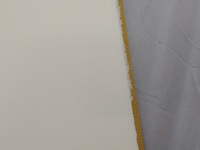
Deckle edge: The edge of handmade paper where the mold cover has resulted in a rough, feathery texture. Deckle edges are usually sliced off by the bookbinder, though they were sometimes left intact.
Image:Doty, Mark. Fire to fire: poems. Winona, MN: Sutton Hoo Press, 2004. PS3554.O798 F55 2004
Deckle edge: The edge of handmade paper where the mold cover has resulted in a rough, feathery texture. Deckle edges are usually sliced off by the bookbinder, though they were sometimes left intact.

Drypoint: An intaglio illustration process where a design is sketched directly onto a plate with a steel point. Drypoint illustration was practiced from the late 1400s onwards.
Image: Chamberlain, Samuel, 1895-1975. Tudor homes of England : with some examples from later periods. New York City: Architectural Book Publishing Company, Inc., 1929. NA7328 .C44
Drypoint: An intaglio illustration process where a design is sketched directly onto a plate with a steel point. Drypoint illustration was practiced from the late 1400s onwards.
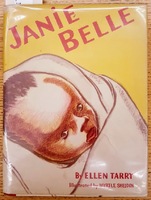
Dust jacket: A protective covering for the cover of a codex book. Initially imagined as a purely disposable wrapping, dust jackets have become intensely collectible and are often heavily illustrated. Older books in particular used them as a place for advertisements. The earliest recorded dust jackets date to 1832.
Image: Tarry, Ellen, 1906-2008. Janie Belle. New York: Garden City Publishing Co. Inc., 1940. PZ7.T18 Jan 1940
Dust jacket: A protective covering for the cover of a codex book. Initially imagined as a purely disposable wrapping, dust jackets have become intensely collectible and are often heavily illustrated. Older books in particular used them as a place for advertisements. The earliest recorded dust jackets date to 1832.
Edition: A technical term for all copies of a book printed with a single setting of type. This is distinct from an impression (all copies printed at one time) and an issue (the number of copies put on sale at any given time). Editions are tied to type and whether the type has been distributed back into its cases or whether it is sitting in the print shop, ready for use. Once stereotyping was invented in the 18th century, the term began to cede much of its importance to impression.
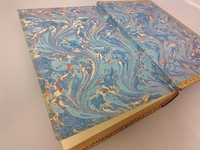
Endleaves: The double leaves added to the front and back of the book between the text block and the covers. One of the endleaves is often pasted down onto the board (this is called a “paste-down”). Since the 17th century, many endleaves have been marbled. Endleaves are also sometimes called “endpapers.”
Image: Casanova, Giacomo, 1725-1798. Mémoires. Selections. English. London: Privately printed for the Navarre Society, 1922. D285.8 .C32 1922 vol. 1
Endleaves: The double leaves added to the front and back of the book between the text block and the covers. One of the endleaves is often pasted down onto the board (this is called a “paste-down”). Since the 17th century, many endleaves have been marbled. Endleaves are also sometimes called “endpapers.”

Engraving: An intaglio illustration process where a design is cut into a metal plate (usually copper). The surface of the plate would be coated with wax and a design transferred to it or sketched in it. Once the design is complete, it can then be cut into the plate using a tool called a burin or a graver. Afterwards, the plate is burnished and cleaned of the remaining wax. Engraving was the most common method for making intaglio plates and is sometimes used as a catch-all term for all forms of intaglio. The oldest known copperplate engravings were produced in the 1430s.
Image: Luiken, Jan, 1649-1712. Afbeelding der menschelyke bezigheden, bestaande in hondert onderscheiden printverbeeldingen. Amsterdam: R. en J. Ottens, ca. 1720. NE670 .L8 A2
Engraving: An intaglio illustration process where a design is cut into a metal plate (usually copper). The surface of the plate would be coated with wax and a design transferred to it or sketched in it. Once the design is complete, it can then be cut into the plate using a tool called a burin or a graver. Afterwards, the plate is burnished and cleaned of the remaining wax. Engraving was the most common method for making intaglio plates and is sometimes used as a catch-all term for all forms of intaglio. The oldest known copperplate engravings were produced in the 1430s.
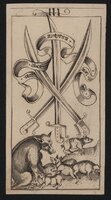
Ephemera: Any non-book printed material. The term can cover anything from movie tickets to broadside posters. It often also has a connotation of being disposable but beware generalizations: baseball cards are absolutely ephemeral and tend to be saved rather than thrown away. Like hardcore pornography, a piece of ephemera is something that you recognize when you see it even if the boundaries of the term are hard to define.
Ephemera: Any non-book printed material. The term can cover anything from movie tickets to broadside posters. It often also has a connotation of being disposable but beware generalizations: baseball cards are absolutely ephemeral and tend to be saved rather than thrown away. Like hardcore pornography, a piece of ephemera is something that you recognize when you see it even if the boundaries of the term are hard to define.

Errata: A list of mistakes made in the printing of a book. Errata lists were often included at the back of a book and might also suggest corrections to the text that the book’s owner could enter themselves. If to err is human, then printers are very human indeed: the first error-free book was not published until 1760.
Image: Aicher, Otto, 1628-1705. Zodiacus vitæ, sive, Iter ethicum. Salzburg: Johann Baptist Mayr, 1697. BF1680 .A3 1697
Errata: A list of mistakes made in the printing of a book. Errata lists were often included at the back of a book and might also suggest corrections to the text that the book’s owner could enter themselves. If to err is human, then printers are very human indeed: the first error-free book was not published until 1760.
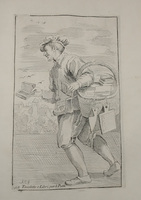
Etching: An intaglio illustration process where a design is burned into a copper plate with acid. To prepare a plate for etching, its surface would first be covered in wax and then the design would be cut into the wax. When the plate was immersed in the acid, the furrows in the wax would allow the acid to bite into the copper, creating the design. Because the image is drawn in the wax rather than having to be manually cut into the metal, etching allows for a freer, sketchier style than engraving does. Etching was developed around 1500.
Image: Carracci, Annibale, 1560-1609. Le arti di Bologna disegnate da Annibale Caracci ed intagliate da Simone Guilini coll' assistenza di Alessandro Algardi. Rome: Gregorio Roisecco, 1740. NC1155 .C28
Etching: An intaglio illustration process where a design is burned into a copper plate with acid. To prepare a plate for etching, its surface would first be covered in wax and then the design would be cut into the wax. When the plate was immersed in the acid, the furrows in the wax would allow the acid to bite into the copper, creating the design. Because the image is drawn in the wax rather than having to be manually cut into the metal, etching allows for a freer, sketchier style than engraving does. Etching was developed around 1500.
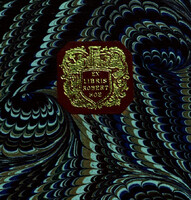
Ex libris: Latin for “From the books” or “from the library.” This phrase often featured on bookplates, especially combined with a name, whether in Latin or in the vernacular. “Ex libris Joannici Adamsensis”, for instance, would mean “From the library of John Adams.”
Image: Veen, Otto van, 1556-1629. Théâtre moral de la vie humaine. Spanish. Antwerp: H. Verdussen, 1733. N7740 .V36
Ex libris: Latin for “From the books” or “from the library.” This phrase often featured on bookplates, especially combined with a name, whether in Latin or in the vernacular. “Ex libris Joannici Adamsensis”, for instance, would mean “From the library of John Adams.”